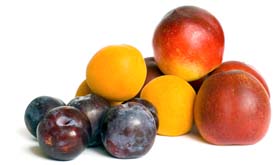Balance the Beat
- By Chris Mittelstaedt
- Reading Time: 2 mins.
My daughters are in a rock band. One plays bass and the other drums. My 10-year old drummer has a problem with The Go-Go’s song “We Got The Beat.” “I keep losing my beat,” she says. “Have you looked in the root vegetable bin?” I chuckle. “Dad, not that kind of beet,” she says. “My beat! Look.” She drums on the table until the rhythm starts to fall out of sequence. “See, my right arm—that’s Hans—has to move so fast that it’s working harder than Emily—that’s my left arm. Emily can’t catch up. It’s making me drum out of balance.” Two weeks later she’s got it under control. “How’d you get things back in balance?” I ask. “Dad,” she says, “I wear thicker socks on my left foot. It balances out Hans.” Duh—I should have known.
 Just like music, being in taste-balance is essential in the fruit world. As we enter the summer stone fruit season, we’re going to experience lots of excellent taste profiles. Naturally hybridized fruits such as apriums are balanced crosses of apricots and plums. Apriums are usually two-thirds apricot and one-third plum, and we see them early in the stone fruit season. (For clarification, plumcots are 50/50 hybrids of plums and apricots, and pluots are more plum than apricot.) Apriums should be eaten when soft to the touch, but don’t let them get too soft or mushy as they’ll quickly move past their prime.
Just like music, being in taste-balance is essential in the fruit world. As we enter the summer stone fruit season, we’re going to experience lots of excellent taste profiles. Naturally hybridized fruits such as apriums are balanced crosses of apricots and plums. Apriums are usually two-thirds apricot and one-third plum, and we see them early in the stone fruit season. (For clarification, plumcots are 50/50 hybrids of plums and apricots, and pluots are more plum than apricot.) Apriums should be eaten when soft to the touch, but don’t let them get too soft or mushy as they’ll quickly move past their prime.
Want fruit for your office?
Get your office a free sample TODAY!Early peaches (whether from Georgia or California) tend to be lighter on the natural sugars, so don’t be surprised if it takes a few weeks for them to build up to those rich and savory peach flavors. Later in the summer, you’ll hear about sub-acid peaches, white-fleshed peaches (with no acids), and others—all with different taste profiles due to their unique mix of sugar, acid, sunlight, water, and ripening stage.
As always, check out our “In the Mix” section for more fruit information.
Enjoy & Be Fruitful! – Chris Mittelstaedt chiefbanana@fruitguys.com


